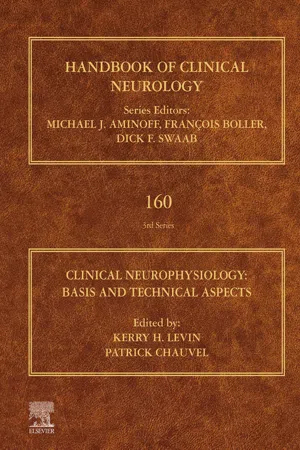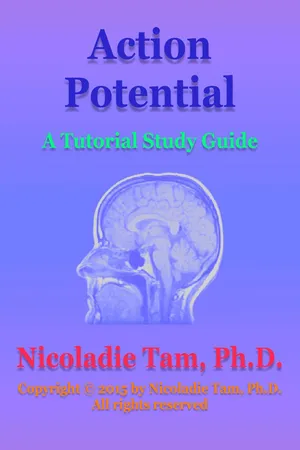Biological Sciences
Action Potential
An action potential is a brief electrical impulse that travels along the membrane of a neuron or muscle cell. It is generated by the movement of ions across the cell membrane, resulting in a rapid change in membrane potential. This process is essential for communication within the nervous system and muscle contraction.
Written by Perlego with AI-assistance
Related key terms
6 Key excerpts on "Action Potential"
- eBook - ePub
- Gary G. Matthews(Author)
- 2013(Publication Date)
- Wiley-Blackwell(Publisher)
When the potential returns toward its resting value, it may transiently become more negative than its normal resting value. The transient jump in potential is called an Action Potential, which is the long-distance signal of the nervous system. If the stretch is sufficiently strong, it might elicit a series of several Action Potentials, each with the same shape and amplitude, as illustrated in Figure 6-1c. Characteristics of the Action Potential The Action Potential has several important characteristics that will be explained in terms of the underlying ionic permeability changes. These include the following: 1 Action Potentials are triggered by depolarization. The stimulus that initiates an Action Potential in a neuron is a reduction in the membrane potential—that is, depolarization. Normally, depolarization is produced by some external stimulus, such as the stretching of the muscle in the case of the sensory neuron in the patellar reflex, or by the action of another neuron, as in the transmission of excitation from the sensory neuron to the motor neuron in the patellar reflex. 2 A threshold level of depolarization must be reached in order to trigger an Action Potential. A small depolarization from the normal resting membrane potential will not produce an Action Potential. Typically, the membrane must be depolarized by about 10–20 mV in order to trigger an Action Potential. Thus, if a neuron has a resting membrane potential of about –70 mV, the membrane potential must be reduced to –60 to –50 mV to trigger an Action Potential. 3 Action Potentials are all-or-none events. Once a stimulus is strong enough to reach threshold, the amplitude of the Action Potential is independent of the strength of the stimulus. The event either goes to completion (if depolarization is above threshold) or doesn’t occur at all (if the depolarization is below threshold) - eBook - ePub
Clinical Neurophysiology: Basis and Technical Aspects
Handbook of Clinical Neurology Series
- (Author)
- 2019(Publication Date)
- Elsevier(Publisher)
Section I Basic physiological and recording conceptsPassage contains an image
Chapter 1Generation and propagation of the Action Potential
Manoj Raghavan; Dominic Fee; Paul E. Barkhaus*Department of Neurology, Medical College of Wisconsin, Milwaukee, WI, United States* Correspondence to: Paul E. Barkhaus, M.D., Professor of Neurology, Department of Neurology, Medical College of Wisconsin, 9200 W. Wisconsin Ave., Milwaukee, WI 53212, United States. email address: [email protected]Abstract
The Action Potential is a regenerative electrical phenomenon observed on excitable cell membranes that allows the propagation of signals without attenuation. It is the cornerstone of neurophysiology. This chapter is a review of the Action Potential and its relationship to the signals that are studied in clinical neurophysiology. The first section traces the history of key scientific discoveries over the last 250 years that have led to our present-day understanding of the electrical properties of nerve and muscle. The second section considers the molecular and biophysical mechanisms that are responsible for the electrical potentials that can be measured across all eukaryotic cell membranes, but specifically in neurons, nerves, and muscle. Mechanisms underlying propagation Action Potentials within the nervous system are also examined. The concluding section is a brief overview of the normal “macroscopic” signals that are commonly recorded from the central and peripheral nervous system, and how they are derived from Action Potentials. - eBook - ePub
- Nicoladie Tam(Author)
- 0(Publication Date)
- Nicoladie Tam, Ph.D.(Publisher)
+ ions puts more positive charges to the outside, the inside becomes more negative relatively. This completes the process for generating an Action Potential for a neuron.*~*~*~*~*Passage contains an image
1.5.Action Potentials
Objectives- Understand the mechanisms for generating action potentials
- Transmission of electrical pulse signal
- Initiation of Action Potential
- Voltage-gated depolarization of membrane
- Threshold potential
- Positive feedback in depolarization of Na-channels
- Effects of opening Na-channels
- Effects of opening K-channels
- Repolarization process
- All-or-none event in Action Potential
Where is Action Potential found? It is found in the axon when a neuron is firing. Action Potentials are propagating along the axonal membrane from the soma to the axon terminal as an electrical signal for communication. Which direction does the Action Potential propagate? It propagates from soma to the axon terminal in a unidirectional manner normally.Action Potential is the nerve impulse, or the neural code used by neurons for processing and communicating. It is an electrical signal consisting of a waveform that can travel very fast along a piece of membrane. This process of wave propagation is called conduction.This direction from soma to axon terminal is the normal direction during physiological condition. Action Potentials can actually propagate in the opposite direction, i.e., they can be backfired if we stimulate them artificially. However, this usually does not happen naturally. We will explain why neurons don’t backfire normally later after we explain the refractory concept. - eBook - ePub
Lecture Notes
Human Physiology
- Ole H. Petersen(Author)
- 2019(Publication Date)
- Wiley-Blackwell(Publisher)
Action Potential — ensues. Neurones and various types of muscle cells are called electrically excitable cells because their membrane properties and composition allow the generation and propagation of such Action Potentials. The Action Potential is probably the most important and fundamental neurophysiological process and, through its rapid and long-distance propagation, it mediates the integrative function of the nervous system.Generation of the Action Potential
In simple terms, an Action Potential is generated by the sudden opening of specialized, fast Na+ channels, which are voltage-dependent. The term ‘voltage-dependent’ means that these channels are sensitive to the membrane potential and are activated when membrane depolarization reaches a certain threshold level (for Na+ channels in most membranes this threshold is ∼−55 mV) (Fig. 4.4 ). Termination of the Action Potential is caused by the activation of another set of voltage-sensitive channels, permeable to K+ . For a more detailed analysis of these events, the time-course of an Action Potential lasting under 5 ms can be divided into several stages (Fig. 4.4a ). Following the resting state (phase 1), during the second phase, local potentials depolarize the membrane. Once the threshold is reached, fast, voltage-dependent Na+ channels are activated and there is a sudden increase in Na+ conductance (gNa ) (phase 3; see also Fig 4.4b ). A powerful feed-forward, self-regenerat-ing process is activated, during which Na+ influx further depolarizes the membrane, activating additional Na+ channels. At rest, the equilibrium potential of the membrane is dictated by the most permeable ion — K+ ; however, during phase 3 of the Action Potential, Na+ conductance is much larger and therefore predominates. Accordingly, the membrane potential will move towards the equilibrium potential for Na+ , as dictated by the Nernst equation —ENa (∼+70 mV). This explains why, during the Action Potential, the polarity of the membrane can be completely reversed (positive charge inside), generating an overshoot. However, the membrane potential rarely reaches ENa , and within less than a millisecond from the initiation of the Action Potential, a peak of depolarization is reached and the repolarization process (phase 4 - eBook - ePub
- Ian N Sabir, Juliet A Usher-Smith(Authors)
- 2008(Publication Date)
- WSPC(Publisher)
As we saw in the Na + -channel inactivation curve (Fig. 8), Na + -channels inactivate as the membrane depolarises, decreasing the number available for activation. These channels then remain inactivated until the E m repolarises. Prolonged depolarisation therefore results in a prolonged decrease in the proportion of Na + -channels available to open which increases threshold as explained above. Conversely, hyperpolarisation of the membrane to values more negative than the resting E m decreases the proportion of inactivated Na + -channels and so lowers the threshold required to initiate a second Action Potential. Action Potentials in Other Excitable Cells The description so far particularly reflects the events occurring during a nerve Action Potential. Other excitable cells express other ion channels which modify the form and duration of the Action Potential. For example, cells of the heart also express voltage-activated Ca 2+ channels, opened as a result of depolarisation attributable to voltage-activated Na + channels. A large transmembrane gradient in [Ca 2+ ] exists (10 4 times higher in the ECF as compared to the ICF) and therefore Ca 2+ flows inwards on channel opening, prolonging the depolarisation. As will be seen in the next chapter, this influx of Ca 2+ is also critical in the initiation of contraction. 1.4 Action Potential Propagation Having understood the ionic basis underlying a single Action Potential, we can now think about how these electrical signals are propagated along nerve axons. The propagation of an Action Potential along an unmyelinated (see later) nerve axon can be modeled as the longitudinal spread of Na + current along an infinitely long insulated cable. The nerve axon is then represented as a network of resistors and capacitors through which this current must flow (Fig - eBook - ePub
- Anne Feltz(Author)
- 2020(Publication Date)
- Garland Science(Publisher)
Action Potentials propagating along axons can carry messages over long distances. For instance, the motor command in the case of the motoneuron axon is carried over more than a meter, from the medulla to the tip of the toe! When a local potential is depolarizing enough, going above a threshold, axons generate an Action Potential that is propagated with no decrement all along the axon. All Action Potentials are identical in amplitude and duration. The characteristics of the message are encoded in a binary way: the signal amplitude is carried by a volley of identical Action Potentials, which are more or less spaced.These two modes of signaling are common to all neurons and present in the whole animal kingdom. How is their spread orchestrated along a single neuron from one end to the other?1.2.2.1 Local graded potentials spread over a few millimeters in a neuron.Physical stimuli on sensory neurons and signals issued from an afferent neuron to another neuron in a NS structure generate local graded currents, the amplitude of which characterizes the intensity of the input signal. The resulting changes of the membrane potential translate dissipation of these currents along a small-diameter conducting tube surrounded by a membrane, which constitutes the cell.The neuronal plasma membrane is bordered by physiological solutions of similar global ionic concentrations but different composition: Na+ is the prevailing cation in the extracellular fluid, whereas the main intracellular cation is K+ . The membrane is only permeant to ions when an ionic channel opens, allowing the flux of an ion down its gradient. Otherwise, it is highly resistant. In basal resting conditions, a small number of K channels are open, allowing a continuous leak of K+ out of the cell, thus generating a negative intracellular potential with respect to the outside, the resting membrane potential (see Chapters 2 and 3 ).When the potential changes at one end of such a conducting tube, a current spreads toward the other end, displacing the cytoplasmic ions. Neurite conductivity is not that good: the slow mobility of the small number of ions present in a unit length of the tube determines the current spread velocity. As a result, the local currents spread slowly. In addition, the membrane is not totally impermeant and further channels may open when the membrane potential is modified by the traveling potential wave. Henceforth, local currents ensue a progressive decrement due to ion leaks across the membrane.
Learn about this page
Index pages curate the most relevant extracts from our library of academic textbooks. They’ve been created using an in-house natural language model (NLM), each adding context and meaning to key research topics.





